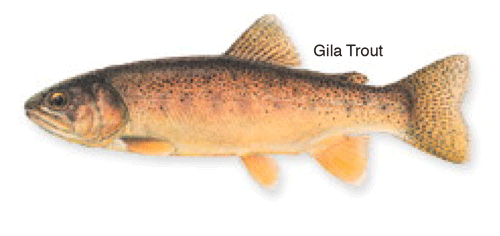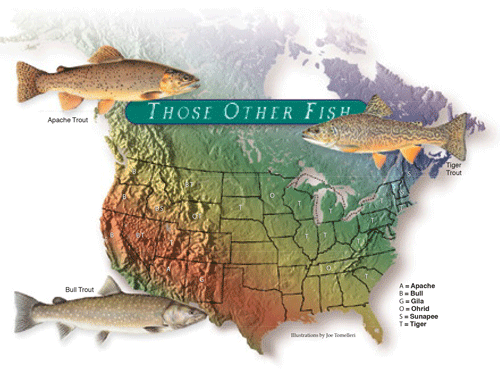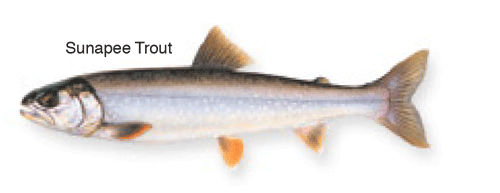

Apache Trout — The Apache trout (Oncorhynchus apache) is native to the White Mountain region of east-central Arizona. This trout was on the endangered species list, but through the efforts of the White Mountain Apache Tribe, the U.S. Fish and Wildlife Service, and the Arizona Game and Fish Department, it has rebounded enough to be listed as threatened, and soon may be off the list. This would make the Apache trout one of the only fish to be removed from the endangered species list. Hybridization with introduced rainbow trout along with competition from non-native brown trout is thought to be the main cause for the Apache’s decline.
Apaches are thick bodied fish with a yellowish-gold color, large black spots, white-edged fins, and an oversized dorsal fin. A black horizontal bar graces their eyes. They’re spring spawners like their close relative, the Gila trout. The world record is shared by two 5-pound 15-ounce fish from Hurricane Lake on the White Mountain Indian Reservation.
Dry flies, nymphs, streamers, small spoons, and spinners all work well. The largest fish are caught from lakes like Hurricane and Christmas Tree on the White Mountain Indian Reservation. To fish there, a special permit is required along with a reservation, as access is limited to a set number of anglers per lake, per day. The Arizona Game and Fish Department raises Apaches in their hatchery system for stocking some state waters.
Bull Trout — Bull trout (Salvelinus confluentus) are actually a char, not a true trout. Endangered in most of its native range, I’ve found record listings for six northwestern states. The world record is a 32-pounder caught from Lake Pend Oreille in Idaho in 1949. Fishing for bull trout in Idaho and most of Montana is illegal, due to the fish’s endangered status.
Bulls resemble Dolly Varden, a species they were originally confused with. They also resemble lake trout, but lack the deeply forked tail. Small bulls are similar to brook trout but lack the vermiculations (wavelike markings) on their backs. Their body is greenish-gray or silvery with creamy or white spots. During the fall spawn, these spots develop a pinkish tint and the belly becomes reddish, similar to spawning brook trout.
Bull trout are an aggressive piscivore. At one time, a bounty was offered for Dolly Varden, as well as the then unknown bull trout, to protect salmon smolts from their predation. Habitat destruction and hybridization with the introduced brook trout have severely reduced bull trout populations.
Sunapee Trout — The Sunapee trout (Salvelinus alpinus) is generally considered a race of landlocked Arctic char. It originally occurred in a few lakes in New Hampshire, Vermont, and Maine. The world record, from Sunapee Lake, New Hampshire, weighed 11 pounds 8 ounces. Some Sunapees were transplanted into two Idaho lakes (Alice and Sawtooth), where they continue to survive. Few true Sunapees remain, as lake trout and brook trout readily hybridize with them.
The two Idaho lakes are believed to still contain true Sunapees. They resemble brook trout although are less colorful and have a more forked tail. Body color is greenish-silver with reddish pink spots. They’re a slim-bodied char, and during the fall spawn, their colors intensify, particularly in males.

Sunapees inhabit deep water during warmwater periods. Lake trout tactics work well if you keep in mind the Sunapee’s smaller size and downsize your lures or bait. In the east, many anglers favor smelt for bait.
Like other char, Sunapee trout spawn in fall in the shallows. In Idaho, most are caught in late fall when they’re shallow. But only a narrow window of opportunity exists, due to unstable weather. In early spring, the fish are shallow, but access to mountain lakes often is difficult. In the east, ice fishing can be effective, but as with other rare and exotic trout, catch and release is highly encouraged.
Gila Trout — Gila trout (Oncorhynchus gilae) are a highly endangered trout found only in a small area in New Mexico and possibly the border of Arizona. They’re protected throughout their range so angling for them is prohibited. Habitat degradation and introduced trout, particularly rainbows that readily hybridize with the Gila, are the main causes of their decline. Most pure-strain Gilas are relegated to tiny intermittent headwater streams, so average size is less than 12 inches. No world record is listed, and even New Mexico doesn’t list a state record.
The Gila is heavily marked with small black spots, an olive back, and coppery or golden sides. The Gila is a chunky fish and a spring spawner like rainbows and cutthroats. A recovery effort is underway; perhaps someday we’ll be able to fish for Gila trout. It’s an excellent candidate for dry-fly fishing as it readily rises to the surface to feed.
Ohrid Trout — Unless you’ve fished in the former country of Yugoslavia, or select waters in Wyoming, Minnesota, or Tennessee, chances are you’ve not heard of, let alone seen an Ohrid trout, Salmo letnica. The Ohrid trout is also known as the Yugoslavian brown or Yugo for short. Ohrids were imported from the Lake Ohrid region of Yugoslavia by the US Fish and Wildlife Service in 1965, because of their tendency to spawn in lakes.
Ohrids look like a greatly exaggerated brown trout. They have oversized fins, huge black and reddish-orange spots, a uniform tan body, and black shading along the belly. Spawning males are brilliantly colored during the spawning season in late January and through February.
In Wyoming, many Yugos are caught by ice anglers fishing fluorescent orange jigging Rapalas in the redds of spawning trout. Apparently, Ohrids bite aggressively when spawning, evidenced by their expelling milt or eggs as they’re pulled from the hole. Due to their slow growth and late maturity, Ohrid stocking has been discontinued, so those you catch are naturally spawned fish, appropriate for release.
The best chance to catch an Ohrid trout in the US probably is at Pathfinder Reservoir in Wyoming. Alcova Reservoir, also in Wyoming, and Watauga Lake in Tennessee, also hold a few of these rare trout. The world record Ohrid, 14 pounds 4 ounces, is a tie between the North Platte River in Wyoming and Watauga Lake in Tennessee. Both were caught in 1986.
Tiger Trout — Tiger trout are not a species, but a hybrid cross between a male brook trout (Salvelinus fontinalis) and a female brown trout (Salmo trutta). They occur naturally, but are more commonly hatchery produced. Due to genetic differences between brookies (a char) and browns (a trout), egg and fry survival is low, ten percent considered excellent. That fact coupled with the sterility of the offspring makes tiger trout rare.
Ten states list a state record, with the world record coming from Lake Michigan, a 20-pound 13-ouncer. Several other states could contain tiger trout, as anywhere brookies and browns are found together, tigers are possible. Wyoming doesn’t list a state record, but I’ve seen several mounted tigers from Wyoming waters.
Tigers are unusual looking with no spots, but their sides are covered with vermiculations. Their coloration usually is brown and yellow. Male tigers, although sterile, develop spawning coloration in fall. Their bellies turn orange, much as a male brook trout’s belly reddens. The tiger’s fins look like a brookie’s, though not as intensely colored.
Tigers aggressively hit large dry flies. Large lures are popular, but I’ve had better luck using small jigs sweetened with bait. Streamers also are worth a try, as both parental species feed on baitfish. Hybrid vigor is responsible for the tiger’s aggressive hits and strong fight. Utah stocks several bodies of water with these exciting hybrids.
This is by no means a complete list of the rare and exotic trout of North America. Several cutthroat subspecies, strains of rainbows, the blueback char, the Canadian aurora trout, and others could be included. Most have recovery programs in place, although few programs have achieved the success of the Apache trout. Hopefully, the Apache success story will someday be repeated for the Gila, Sunapee, bull, and other rare and endangered trout. Catch and release along with angler support of recovery programs may provide future anglers with the opportunity to catch these rare and exotic trout.
* Danny Kurttila is a freelance writer from Riverton, Wyoming.











































